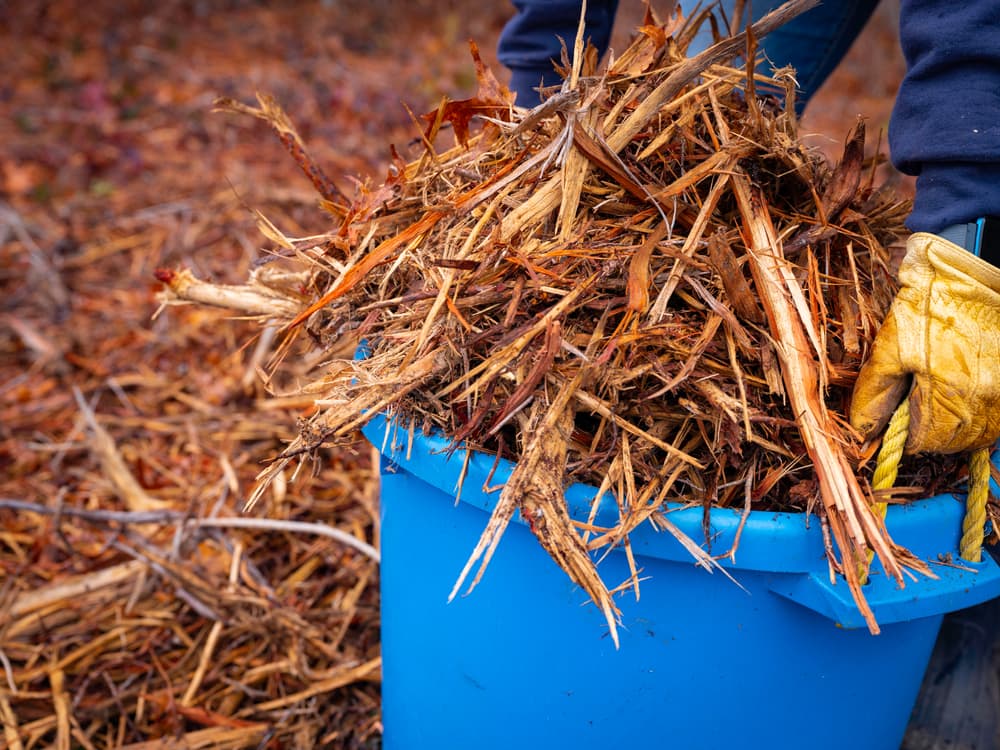No Dig Gardening Explained For Beginners: Experts Share The Benefits And Their Advice


Elizabeth is a Permaculture Garden Designer, Sustainability Consultant and Professional Writer, working as an advocate for positive change. She graduated from the University of St. Andrews with an MA in English and Philosophy and obtained a Diploma in Applied Permaculture Design from the Permaculture Association.
Reviewed By DAN ORI

Dan has over 27 years’ under his belt caring for plants and gardens. Working as a Horticultural Instructor and Consultant, he draws on a diverse range of experience that includes working as a Head Gardener, Tree Surgeon, Garden Centre Trouble Shooter, and writer of academic papers. Dan has a Level 3 Diploma in Horticulture and is currently a candidate for the RHS’s most prestigious award – The Master of Horticulture.
Contributions From KATE COTTERILL , CHARLES DOWDING

Charles Dowding is a Horticulturist best known for his pioneering work on the concept of 'no-dig gardening'. He is the author of several books on the subject, including his most recent 2022 publication ‘No Dig’, and runs several courses and lectures too. He has over 600,000 subscribers on YouTube, where he shares useful videos on organic gardening.

Jenny Thompson, known online as Organic Allotment Girl, is an allotment grower, blogger and is currently an Assistant Kitchen Gardener at The Riverford Field Kitchen in Dartmoor. She has her own flower farm and provides cuts and dried bouquets to her customers. Jenny holds a Permaculture Design Certificate from the Apricot Centre in Totnes.

Kim Stoddart is a climate change gardener and the co-author of ‘The Climate Change Garden’, which was updated and republished in February 2023. She teaches courses for the RHS and has also written for publications such as The Guardian and Country Smallholding.

Stephanie Hafferty is a No-Dig Kitchen Gardener who has published several award-winning books on organic growing and appeared on several UK TV shows. In 2021 she produced a demonstration garden for the RHS at Hampton Court with Charles Dowding. Stephanie is Co-Vice Chair of the Garden Media Guild and a member of the Guild of Food Writers.
Learn all about no dig gardening, this eco-friendly and sustainable organic gardening method.
As you read about organic gardening, you will no doubt come across the term ‘no dig gardening’ or ‘no till’ and may wonder what it means.
No dig gardening is not complicated, but it does depart from some ‘traditional’ gardening lore.
“Some people think it’s a lazy form of gardening, but the truth is you must put a lot of effort into making your own compost, sourcing compost and collecting mulches,” says Garden Blogger Jenny Thompson.
“Try shifting and spreading over 3,000 litres of compost onto beds and I can assure you it’s not for the idle gardener!”
While some traditionalists may baulk at this idea, it is now increasingly apparent that gardening in this way is the best way to maintain a healthy and productive organic garden.
What Is No Dig Gardening?

No dig gardening is a term that is largely self-explanatory.
In a no dig garden, you do not dig or till to prepare the soil in your growing areas or to work in organic matter.
Instead, you lay organic matter on top of the soil and you let nature do the work for you.
The goal is to leave the soil as undisturbed as possible.
“No dig gardening – how did I not have that earlier in my life?” says Kate Cotterill, Organic Gardener.
“It liberates you completely. Once you get your plants off the ground, it means you spend a lot less time digging over your garden and weeding.”
“There are also so many other benefits to it.”

Since the soil in a no-dig garden is left largely undisturbed, the complex web of soil life is allowed to thrive.1No Dig Gardening. (2023, February 16). Garden Organic. Retrieved March 21, 2023, from https://www.gardenorganic.org.uk/expert-advice/garden-management/soil/the-nodig-method
And that life, from the earthworms to the microscopic bacteria and fungi, will slowly break down the organic matter and incorporate it into the soil.
“I first started dabbling with nodig back in 2014 after my gardens flooded,” shares the Climate Gardener Kim Stoddart.
“I realised how this approach could help to build soil structure to help the ground cope with more water than dug-over soil. There are so many benefits as we now know.”
In no dig gardening we:
- Don’t dig or till wherever possible.
- Take steps to avoid soil compaction.
- Keep the soil covered with mulches or living plants at all times, keeping a living root in the soil as frequently as we can.
“I think once you understand even a little about soil biology, it’s hard to refute the principles of no-dig,” says Jenny.
“With no dig, we practice minimal soil disturbance. This allows the organisms within the soil to flourish.
“The web of life that exists within healthy soil is mind-blowing. One teaspoon of healthy soil can contain more microorganisms than there are people on the planet.”
Understanding Organic Matter
If you are new to gardening, you might not be familiar with the term organic matter.
This is a term that it is vital to understand if you are trying to garden successfully in an organic, sustainable way.
Organic matter is material containing carbon that derives from living things. In general terms, it is dead plant or animal matter, and animal waste.2Funderburg, E. (2001, August). What Does Organic Matter Do In Soil? Noble Research Institute. Retrieved March 21, 2023, from https://www.noble.org/news/publications/ag-news-and-views/2001/august/what-does-organic-matter-do-in-soil/
Soil organic matter is one component of a healthy, living soil. And gardeners add organic matter to improve the soil and add fertility.
The types of organic matter added to soil might be brown organic matter: composts, manures and rotted dried leaves (leaf mould).

They might be green organic matter – green leaves, vegetable scraps etc.

Learning how to add more organic matter in your garden is always crucial to success.
It might be helpful to think about the organic matter as “nature’s recycling”.3Nature’s nutrient cycle. (2019, September 30). European Environment Agency. Retrieved March 21, 2023, from https://www.eea.europa.eu/signals/signals-2019-content-list/infographics/agriculture/view
Adding organic matter to the soil surface in your garden growing areas mimics the natural processes which take place in nature on a forest or woodland floor.
The leaves fall, and begin to decay, and the complex web of soil life returns the nutrients they contain to the system.
No dig gardening is about harnessing this natural process to create a closed-loop, natural system in your cultivated garden.
“No dig works with nature, not against it and helps to make gardening more accessible for many people,” says Stephanie Hafferty, an Organic Gardener.
No Dig Benefits
Understanding why no dig gardening is a good idea involves understanding soil.
Soil is far more than just ‘dirt’.

Healthy soil is a living ecosystem, which we depend upon for almost all our gardening endeavours.
It is made up of:
- Minerals
- Air
- Water
- Organic Matter
- Living Organisms
No dig gardening is the best approach to keep these elements in balance, and the precious soil ecosystem functioning as it should.
“All plants love it,” shares No-Dig Pioneer Charles Dowding.
“An easy one for starting in springtime is potatoes or garlic (cloves) in October.”

Remember, without the soil, we could not grow anything in our gardens.
“No dig gardening protects mycorrhizae, other fungal networks and soil life (bacteria, nematodes etc) which creates excellent growing conditions for plants,” says Stephanie.
“Digging destroys this vital ecosystem.”
We rely on the soil for so much, so we should always be sure to take care of it.
Environmental

When we dig or till the soil, and when we leave it bare, we cause damage to this ecosystem.
The soil can more easily lose its nutrients, be eroded by wind and rain and become compacted or overly saturated.4Begum, T. (2021, April 16). Soil degradation: the problems and how to fix them. Natural History Museum. Retrieved March 21, 2023, from https://www.nhm.ac.uk/discover/soil-degradation.html
When we disturb the soil, the beneficial organisms working away below the surface decrease, and the fertility of the soil slowly diminishes over time.5Gray, R. (n.d.). Why soil is disappearing from farms. BBC. Retrieved March 21, 2023, from https://www.bbc.com/future/bespoke/follow-the-food/why-soil-is-disappearing-from-farms/
We now know that the no-dig approach helps the microbiome in the soil, so your plants are, in turn, healthier,” says Kate.
“This also means you can grow plants closer together, as the soil is richer in nutrients and retains water well, which is better for the environment.”
Research from IPCC has confirmed that tilled or dug soil also becomes an emitter of carbon and greenhouse gases.6Mangalassery, S., Sjögersten, S., Sparkes, D. L., Sturrock, C. J., Craigon, J., & Mooney, S. J. (2015). To what extent can zero tillage lead to a reduction in greenhouse gas emissions from temperate soils? Scientific Reports, 4(1). https://doi.org/10.1038/srep04586
Their work found that tilled soil produced 31% greater Global Warming Potential than non-tilled soil (on an area basis).
So no dig gardening can also help you play a role in tackling our climate crisis.
By keeping soil covered and avoiding disturbance and bare soil, a no dig gardening approach increases the amount of carbon stored in the soil in your garden – keeping it out of the atmosphere where it causes global warming.
Increasing Yields

What is more, no dig gardening can often be easier for the gardener too, since you will avoid the back-breaking work involved in digging garden beds manually.
Gardeners and researchers are discovering that taking a no dig approach can increase yields and enhance species diversity over time.7Grosvenor, G. (2020, July 19). No-dig gardening and chaos planting yields many rows of surprises. Whitchurch Herald. Retrieved March 21, 2023, from https://www.whitchurchherald.co.uk/news/18590842.no-dig-gardening-chaos-planting-yields-many-rows-surprises/
This is the most effective way to build new garden growing areas and to maintain existing beds and borders.
No Dig Garden Bed Types
If you would like to create a new growing area in your garden, there are several different ways to do so if you are taking a no dig approach. The most common options are:
- Lasagne Gardens
- Hugelkultur
- Straw Bale Gardens
Lasagne Gardens

A lasagne garden is a no dig bed which is, essentially, a type of composting.
The idea is to layer organic matter on top of the soil.
Since (just like in a composting system) you add different layers, the idea is called ‘lasagne gardening’.
Just as you would build up the layers in the classic Italian dish, so too, in a lasagne garden, you layer up the natural ingredients to prepare your growing area.

To make a lasagne garden you:
- Mark out the area for your new bed, adding bed edging if you wish to keep things neat. Remember that you can use a range of natural or reclaimed materials as bed edging. Make sure that you can easily reach all parts of the bed, so you will not step on and compact it.
- Layer untreated cardboard over the soil (or grass if you are creating the area over a lawn).
- Add a layer of carbon rich material (wood chips, dry leaves, straw, bracken etc.) over the cardboard. Aim for around 5cm in depth.
- Next, add a 5cm layer of nitrogen rich material (green leaves, manure, vegetable scraps etc.)
- Continue to layer carbon rich and nitrogen rich materials until your bed is at least 35cm deep (or the required height for the raised bed).
- Add a final layer of good quality compost, topsoil or loam into which you can plant.
- Water the area well, making sure that the layers are all moistened.
- Plant up your new raised bed.
- Mulch around the plants with a suitable organic mulch. Different plants will require different mulches, since different types of organic matter will have different properties and provide different nutrients.
Hugelkultur

Hugelkultur is another type of no dig raised bed.
The word hugelkultur comes from the German for ‘mound culture’.8Henderson, J. (2022, December 16). Hügelkultur Gardening. EcoFarming Daily. Retrieved March 21, 2023, from https://www.ecofarmingdaily.com/eco-farming-index/hugelkultur-gardening/
A hugelkultur bed is a mounded bed which is built up in much the same way as a lasagne bed – with one key difference.
Before the layers are added, as above, a central core of rotting wood is created.
This core forms the skeleton of the new growing area, creating a hilled shape, usually at least 50cm and sometimes up to 1.5m or more high at the centre, rather than a flat-topped bed.

The wood slowly decomposes and the mound will sink over time, but as it does so, it will retain plenty of moisture, and harbour plenty of beneficial life.
Another benefit of hugelkultur is that it increases the growing area available.
The mounded shape also provides different environmental conditions, so that a number of different plants with different needs can be grown in a smaller area.
Plants that prefer sunnier conditions can be placed on the south or west side of the mound, and those which like less sun to the south or east.
Moisture-loving plants will thrive near the base of the sides, while those with deeper roots, and/or more drought tolerance, go at the top.
Once the central core is created, you should proceed to add the outer layers as above.
You can then plant up the mound to stabilise the sloping sides right away.
Straw Bale Gardens

One other interesting idea to consider is straw bale gardening.
As the name suggests – this involves growing plants in the tops of straw bales, rather than in the soil.
Strawbales can sometimes be found free of charge from local farms as an agricultural byproduct, or (more commonly) purchased for a small price.

The bales can simply be placed where you wish your new growing area to go.
They will break down over time and can be contained with bed edging for a neater appearance.

The bales should then be watered with a compost tea or other nitrogen-rich feed to begin the process of decomposition – and topped with a layer or with planting pockets of good quality compost into which plants can be placed.
Experienced Horticulturist Dan Ori does offer a word of warning though: “Although straw can be a good growing medium it can take a lot of water to work well.
“Both straw, hugelkultur, and lasagne beds with straw can encourage high slug and snail populations.
“If you already have an abundance of slugs and a shortage of water, my recommendation would be to try a layering system, adding additional well-rotted garden compost on top after each harvest.
“You will need plenty of compost with no-dig, so to save buying in too much, get composting quick!”
Transforming An Existing Garden Bed

Even if you do not want to create a new growing area, you can still get started with no dig gardening.
Converting to no dig simply involves sheet mulching – laying organic matter over the soil surface to protect it and gradually improve it over time.
Mulching
“The best tip for no-dig gardening is just mulch, mulch and more mulch,” explains Jenny.
“Ideally, lay a thick layer of homemade compost once a year, but I also use grass clippings, fallen leaves and even seaweed (rinsed first to wash excess salt off).”
Any areas of bare soil should be covered – either with living plants or with organic mulches.
Remember, mulches should be chosen with reference to the plants already growing in the area.
Generally, the best time to add a mulch is in the spring, though mulches can be added at any time of the year.
If you are sheet mulching around existing plants, there is one important thing to remember – keep the mulch away from the trunks or stems of the plants.

Mulch piled around the base of plants can cause them to rot.
Heavier mulches with woody material are best restricted to perennial shrubs and trees, since woody material will sequester nitrogen (one of the essential plant nutrients) as it breaks down.
Though you can add woody material as part of a mixed mulch as long as there is also plenty of nitrogen-rich material to provide the additional nitrogen required.
It is often a good idea to grow plants that provide you with materials for mulches.
Many plants grow quickly and are good at accumulating certain specific nutrients.
Plants that are good at gathering certain nutrients are called dynamic accumulators.9Kitsteiner, J. (2015, April 10). The Facts about Dynamic Accumulators. The Permaculture Research Institute. Retrieved March 21, 2023, from https://www.permaculturenews.org/2015/04/10/the-facts-about-dynamic-accumulators/

These can be chopped and dropped as mulches around existing plants.
But the most important resource to have in a no dig garden is a good quality compost and of course, it is much cheaper, easier and more eco-friendly if you make your own.
Maintaining A No Dig Garden

Once you have created a no dig gardening area, maintenance is all about keeping the soil covered with plants and mulches and building up new layers of organic matter over the area over time.
Usually, mulches will be replenished each spring, just before the start of the main growing season – compost will often be added when switching out crops in rotation.
Other mulches may also be added for specific purposes and at specific times.
Placing a mulch of potassium-rich comfrey leaves around tomatoes when they begin to set fruit is one example.
“Mulching is a resilient must and can help further boost soil health and lock in moisture into the ground to make it easier on plants and gardeners during a period of heat,” adds Kim.
“You can use all sorts of materials you might already have to hand, such as compost, woodchips, leaf mold, grass clippings, compost, cardboard, wool, seaweed or even nibbled plant leaves – it all helps!”
Weeding

Weeding is much reduced in a no dig garden, since mulches suppress weed growth.
And since the soil is not disturbed, fewer weed seeds are exposed to the light and germinate.
But you may well still need to weed here and there in a no dig garden.
Weeds are usually lightly hoed, or pulled by hand little and often.
Planting Consistency
Remember that it is always best to keep living plants in the soil as much as possible, as Kim explains:
“I would recommend trying to use ground cover plants as much as you can to further protect soil from drying out.
“Also consider what I call a free-planting approach, which basically means leaving a lot of space (about 6ft) between many plants of the same family to help reduce the risk of pests and airborne fungi, both of which are a major threat with climate change.”
This means thinking about successional sowing throughout the growing season, and about placing cover crops or green manures in the ground over the winter months or during gaps in rotation.
No dig gardening is a great choice for any organic garden.
There is of course more to learn, but this beginner’s guide should help you get started in your garden.
References
- 1No Dig Gardening. (2023, February 16). Garden Organic. Retrieved March 21, 2023, from https://www.gardenorganic.org.uk/expert-advice/garden-management/soil/the-nodig-method
- 2Funderburg, E. (2001, August). What Does Organic Matter Do In Soil? Noble Research Institute. Retrieved March 21, 2023, from https://www.noble.org/news/publications/ag-news-and-views/2001/august/what-does-organic-matter-do-in-soil/
- 3Nature’s nutrient cycle. (2019, September 30). European Environment Agency. Retrieved March 21, 2023, from https://www.eea.europa.eu/signals/signals-2019-content-list/infographics/agriculture/view
- 4Begum, T. (2021, April 16). Soil degradation: the problems and how to fix them. Natural History Museum. Retrieved March 21, 2023, from https://www.nhm.ac.uk/discover/soil-degradation.html
- 5Gray, R. (n.d.). Why soil is disappearing from farms. BBC. Retrieved March 21, 2023, from https://www.bbc.com/future/bespoke/follow-the-food/why-soil-is-disappearing-from-farms/
- 6Mangalassery, S., Sjögersten, S., Sparkes, D. L., Sturrock, C. J., Craigon, J., & Mooney, S. J. (2015). To what extent can zero tillage lead to a reduction in greenhouse gas emissions from temperate soils? Scientific Reports, 4(1). https://doi.org/10.1038/srep04586
- 7Grosvenor, G. (2020, July 19). No-dig gardening and chaos planting yields many rows of surprises. Whitchurch Herald. Retrieved March 21, 2023, from https://www.whitchurchherald.co.uk/news/18590842.no-dig-gardening-chaos-planting-yields-many-rows-surprises/
- 8Henderson, J. (2022, December 16). Hügelkultur Gardening. EcoFarming Daily. Retrieved March 21, 2023, from https://www.ecofarmingdaily.com/eco-farming-index/hugelkultur-gardening/
- 9Kitsteiner, J. (2015, April 10). The Facts about Dynamic Accumulators. The Permaculture Research Institute. Retrieved March 21, 2023, from https://www.permaculturenews.org/2015/04/10/the-facts-about-dynamic-accumulators/

